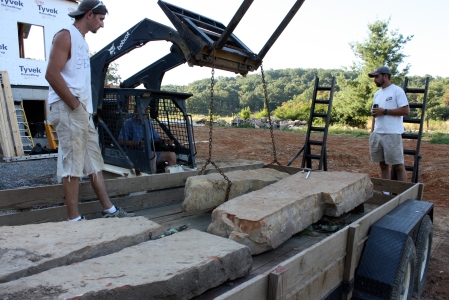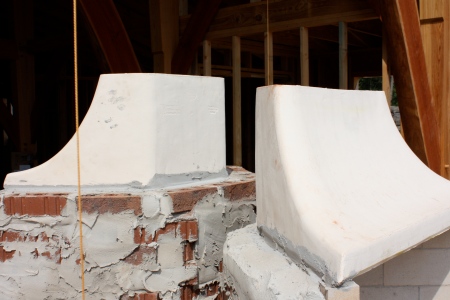Kelley has been on his toes for the past few weeks, keeping up with all the activity at Bunny Vista. We’ve had crews of electricians, plumbers, and roofers, in addition to Lewis, Braxton, and Aaron, and sometimes the area between the house and the trailer looks like a big traffic jam. The plumbers have finished the roughing in, and the plumbing passed inspection with flying colors. The electricians have wired the log rooms, the hallways, and the kitchen; with the log rooms wired, Braxton has been able to finish chinking the office, hallways, and guest bathroom. We continue to consult about wiring for the timber frame section, while we wait for the electrician to return.
The roofers have arrived and have begun laying the cedar shingles. The roof is gorgeous. I have another post partially written about the cedar Kelley found for the roof, and I’ll post it as soon as Kelley takes a few more photographs.
In other construction advances, Eric Thompson arrived with drawings for the heating and cooling system and lots of ideas for placement for the cooling ductwork and vents. The insulation guy has given us an estimate on the non-log portions of the house. Kelley has painted the walls of the mechanical room, and we are expecting the crew from the electric company to be here soon to run the line to the new house. The meter is in place, and the electrical panels passed inspection. Kelley says that John Boody has the kiln just about ready to dry the poplar bark and the flooring wood. Kelley has ordered the windows and doors from a company in Harrisonburg, which required much price comparing, compromising, and hair-pulling. I can hardly wait for the windows to arrive. The rest of the skylights are on order and should be here tomorrow or the next day.
Yesterday, Kelley and I went to look at tin lighting fixtures at Early American Tin Lighting, which is a small shop in the basement of an amazing log house several miles west of Ottobine. It was my first visit to Ottobine, which is about six miles west of Dayton. There is a large Mennonite community in that area. We spent several hours talking with Mike Walsh, the owner of the shop. We picked out three tin sconces for the log rooms, a chandelier for the hallway between the log rooms, two triangular exterior lanterns, a chandelier for the dining area, and three pendants for the kitchen. My heart is still beating pretty fast, and I am contemplating the purchase of a lantern for the lamp post, another sconce for the entry, and two more triangular lanterns for the big front porch. Kelley is trying, without much success, to calm me down. I had not intended to choose so many fixtures, but they were very beautiful and just seemed to fit the character of Bunny Vista so well.
Lewis has been hard at work on the two Bunny Vista fireplaces, which are back-to-back with one fireplace in the the timber frame room and one on the screened porch. He is building them of the same sandstone he used for the foundation of the screened porch, and I have been slipping up to the house every evening to check on the progress. The fireplaces are unbelievably beautiful, even in their unfinished state.
When Erin saw them a couple of weeks ago, she noticed immediately that they are very shallow. And Kelley was very happy to explain that the fireplaces are called Rumford fireplaces and are of a special design developed in the 18th century by Count Rumford. They were common from the late 18th century until the mid 19th century, when fireplaces were the main source of heat in many houses. They are tall and shallow and have narrow throats with curved and streamlined throats. Thomas Jefferson had Rumford fireplaces at Monticello, and I understand that Henry David Thoreau called them modern conveniences that everyone “takes for granted.”
Count Rumford was born Benjamin Thompson in Massachusetts in 1753. He was a British loyalist and left Massachusetts in 1776 to live in Europe. He was employed by the Bavarian government for many years, where he was given the title “Count of the Holy Roman Emperor” and was known for his work on the nature of heat. He also lived for some years in England where he published papers on his ideas for improving fireplaces. His fireplace design, tall and shallow with widely splayed sides, allowed more of the fire’s radiant heat to actually heat the room rather than escape up the chimney. To keep smoke from pouring into the room, a particular problem of this design, he redesigned and streamlined the throat of the fireplace so that the smoke shoots up the chimney.
Kelley ordered the Rumford components of the fireplace from Superior Clay Corporation, and Lewis set to work.

Kelley and Lewis bought these large stones near Goshen from the same place they found the poplar bark. The largest stone will be the hearth.








